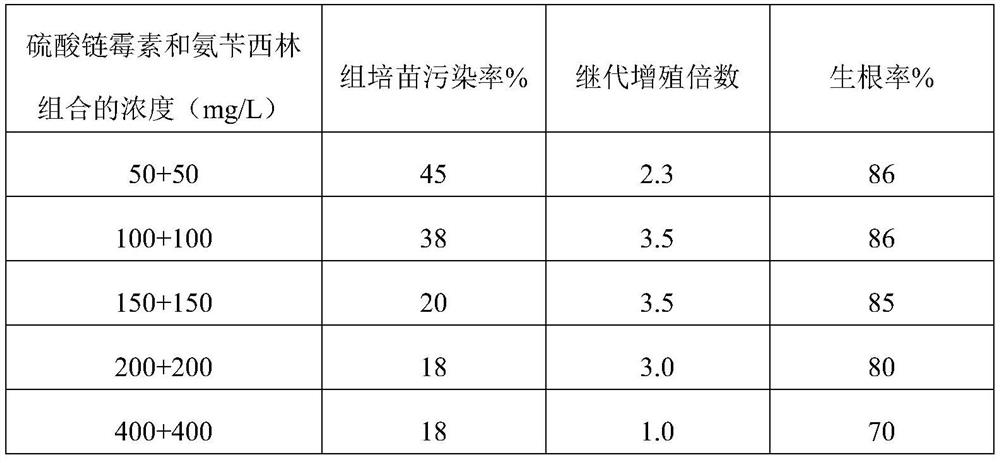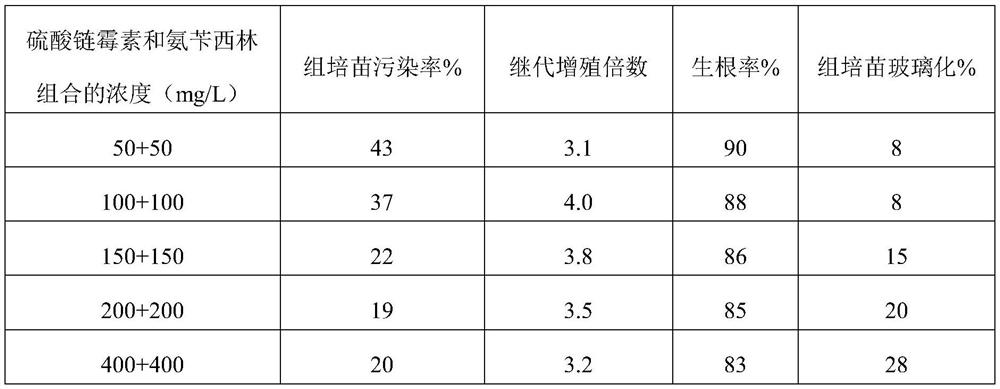Method, cultivation method and application of removing endophytic bacteria in sagittarius cultivating process
A cultivation method and technology of Sagittarius, which is applied in the field of treatment of proliferating Sagittarius tissue culture seedlings, and can solve the problems of insufficient supply of culture materials and high endophyte contamination rate
- Summary
- Abstract
- Description
- Claims
- Application Information
AI Technical Summary
Problems solved by technology
Method used
Image
Examples
Embodiment 1
[0035] Embodiment 1: the impact of streptomycin sulfate on Sagittarius tissue cultured seedlings
[0036] In this embodiment, the Arthroatia sagitta tissue culture seedlings are cultivated using a semi-solid medium, wherein the formula of the semi-solid medium includes: MS+2.5mg / L of 6-BA+0.01mg / L of NAA+3.5g / L of carrageenan +30g / L sucrose, each bottle contains 30ml medium.
[0037] As can be seen from the following table 1, when the concentration of streptomycin sulfate was 50mg / L, the pollution rate of arrowhead tissue cultured seedlings was 42%, the subculture multiplication factor was 1.0, and the rooting rate was 85%; When the concentration of streptomycin was 200mg / L, the pollution rate of sagittarius tissue cultured seedlings was reduced to 23%, the subculture multiplication factor was 2.1, and the rooting rate was 72%; however, when the concentration of streptomycin sulfate was 400mg / L, sagittarius The pollution rate of the tissue culture seedlings was almost the sam...
Embodiment 2
[0041] Embodiment 2: the influence of ampicillin on the tissue culture seedling of sagittarius
[0042] In this example, the tissue-cultured seedlings of Sagittarius quinceus were cultured using a semi-solid medium, wherein the formula and volume of the semi-solid medium were the same as those in Example 1.
[0043] As can be seen from the following table 2, when the concentration of ampicillin was 50mg / L, the pollution rate of sagittarius tissue cultured seedlings was 62%, the subculture multiplication factor was 1.0, and the rooting rate was 73%; when the concentration of ampicillin was 150mg / L, the pollution rate of Sagittarius tissue-cultured seedlings was 42%, the subculture multiplier was 2.0, and the rooting rate was 80%; and when the concentration of ampicillin was 200mg / L, the pollution rate of Sagittarius tissue-cultured seedlings was reduced to 35%. %, the subculture multiplier no longer increased, and was still 2.0, and the rooting rate began to decrease, which wa...
Embodiment 3
[0047] Embodiment 3: the impact of streptomycin sulfate and ampicillin on Sagittarius tissue culture seedlings in semi-solid culture
[0048] In this example, the tissue-cultured seedlings of Sagittarius quinceus were cultured using a semi-solid medium, wherein the formula and volume of the semi-solid medium were the same as those in Example 1.
[0049] Streptomycin sulfate and ampicillin are made into a solution, wherein the preparation method of the streptomycin sulfate solution comprises: weighing 50 mg of powdery streptomycin sulfate, dissolving it in absolute ethanol, and finally settling to 1 L to prepare Concentration is the streptomycin sulfate solution of 50mg / L; The preparation method of described ampicillin solution comprises: take by weighing the powdery ampicillin of 50mg, be dissolved in water, be finally settled to 1L, make concentration be 50mg / L Ampicillin solution.
[0050] As can be seen from the following table 3, when the concentration of streptomycin sul...
PUM
 Login to View More
Login to View More Abstract
Description
Claims
Application Information
 Login to View More
Login to View More - R&D
- Intellectual Property
- Life Sciences
- Materials
- Tech Scout
- Unparalleled Data Quality
- Higher Quality Content
- 60% Fewer Hallucinations
Browse by: Latest US Patents, China's latest patents, Technical Efficacy Thesaurus, Application Domain, Technology Topic, Popular Technical Reports.
© 2025 PatSnap. All rights reserved.Legal|Privacy policy|Modern Slavery Act Transparency Statement|Sitemap|About US| Contact US: help@patsnap.com


